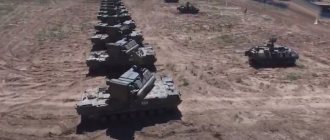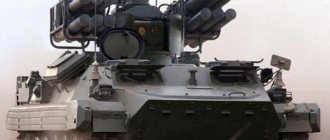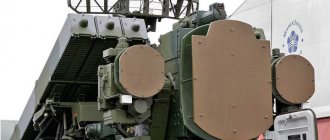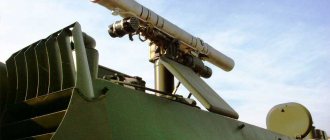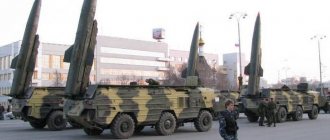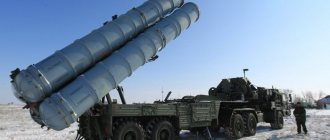S-75 air defense systems Dvina, Desna, Volkhov. Compound. Rockets. Damage range
The S-75 anti-aircraft missile system (SA-2 “Guideline”) is designed to engage air targets at medium and high altitudes on a collision course and in pursuit. The transportable (towed) complex was developed to cover important administrative, political and industrial facilities, military units and formations. The S-75 is single-channel for a target and three-channel for a missile, i.e., it is simultaneously capable of tracking one target and pointing up to three missiles at it.
Photo gallery[ | ]
- The wreckage of the American U-2 reconnaissance aircraft Gary Powers, shot down over the Soviet Union
- The wreckage of the American U-2 reconnaissance aircraft Rudolf Anderson, shot down over Cuba
- Wreckage of an American U-2 reconnaissance aircraft shot down over China
- A Soviet crew launches an S-75 air defense missile at an American aircraft over Vietnam
- American plane explosion
- Glass in the cockpit of a B-52 broken by shrapnel from a C-75 over Vietnam in 1972
- SAM approaching the reconnaissance Phantom
- Shot down of an American Phantom by an S-75 air defense missile over Vietnam
- A S-75 missile flies into an American F-105 over Vietnam
- American F-105 catches fire after being hit by shrapnel
S-75 air defense system - video
Development of the complex began in 1953 at KB-1 (now Almaz). General designer A. Raspletin. The anti-aircraft guided missile was developed at the Fakel design bureau, general designer P. Grushin. The complex was created on the basis of technical solutions implemented during the development of the S-25 system. The launcher is single-beam with a variable missile launch angle and an electric drive for turning in angle and azimuth - designed at the Leningrad TsKB-34.
In 1955, an experimental test site version of the complex was created and the first missile launches were carried out. By mid-1956 An experimental model of a mobile missile guidance station was created. The entire complex is located in six cabins. The equipment cabins were located in car vans, the receiving and transmitting equipment with antennas was on a KZU-16 artillery cart, and the launchers for transportation were installed on special wheeled chassis. The complex had six launchers, which were located in a circle around the missile guidance station (MNS). In 1957, the complex called SA-75 “Dvina” entered service with the country’s air defense forces. The system's radar (missile guidance station) operated in the E-band. The complex fired at the target with V-750 (1D) and V-750V (13D) missiles. The development of the S-75 Desna medium-range air defense system began in 1956, and a prototype test site was created in 1957.
Taking into account the shortcomings of the SA-75 air defense system and other reasons, the new S-75 complex was designed with the equipment located in towed van bodies mounted on the chassis of a car trailer. The complex fired at targets with missiles of the new type V-750VN (13D) and had an expanded destruction zone compared to its predecessor. With the start of serial production and deliveries to the troops of the three-cabin version of the S-75 Desna complex, production of the SA-75 was curtailed. Taking into account the shortcomings of the SA-75 air defense system and other reasons, the new S-75 complex was designed with the equipment located in towed van bodies mounted on the chassis of a car trailer. The complex fired at targets with missiles of the new type V-750VN (13D) and had an expanded destruction zone compared to its predecessor. With the start of serial production and deliveries to the troops of the three-cabin version of the S-75 Desna complex, production of the SA-75 was curtailed.
The Vietnam War was the reason for a number of modifications to the Dvina complex. In total, 6 development projects were carried out with practical testing at the test site and subsequent implementation on equipment in Vietnam. A false launch mode was introduced, i.e., turning on the radio command transmitter for missile control without launching the missile. Having received such a signal on their reconnaissance receiver, tactical aviation pilots performed an anti-missile maneuver and thereby differed from strategic aviation aircraft, which could not perform such maneuvers.
The next modification was the S-75M Volkhov complex, which differed from the previous ones in the type of V-755 missiles used (20D and 20DP), as well as the presence of two parabolic antennas on the receiving and transmitting cabin. In the new rocket, instead of two antennas in the radio fuse, four were used, and the design of the rocket's propulsion engine was slightly changed. The missile guidance station operated in the G-wave band. Narrow beam parabolic antennas were installed on the wide beam azimuth antenna, which increased the capabilities of the complex when working against small targets and in interference conditions.
The complex made it possible to fire at targets in conditions of active and passive interference. The S-75M entered service with the air defense forces in May 1961, and in 1962 it was adopted by the air defense forces of the ground forces. The complex was equipped with a communications cabin and interface with the automated control system, which allowed the missile guidance station to operate in automated external target designation mode. The use of automated control systems has made it possible to increase the effectiveness of the combat use of air defense systems. Later, variants of the S-75M2, S-75MZ complex were developed, differing in the type of missiles used (20D, 5YA23) and the introduction of new operating modes of the SNR-75 for protection against interference. The complex was modified many times; at the last stage, a teleoptical sight was installed on the transmitting and receiving cabin. The television camera made it possible to fire at targets in conditions of electronic suppression of the SNR-75.
The rockets of all serial modifications are two-stage, made according to the normal aerodynamic configuration. The first stage (starting accelerator) is solid propellant and is a powder jet engine operating for 4.5 s. The second stage has a liquid jet engine powered by a combination of kerosene and nitric acid. All-moving rudders for pitch, yaw and roll control are located on the tail section of the sustainer stage, and ailerons for roll control during the flight phase with the launch accelerator are located on the launch accelerator in one plane. To reduce longitudinal static stability, trapezoidal destabilizers are placed in the nose of the rocket on rockets of early modifications and triangular destabilizers on rockets of later series. The warhead is a high-explosive fragmentation unit weighing 196 kg (for 20D missiles) and 190-197 kg (for 5YA23). The radius of destruction of the warhead can reach 244 m against U-2 type targets. For small targets such as a fighter, the damage radius is reduced to 65 m.
The large radius of destruction allows you to compensate for errors in the guidance system. According to foreign press reports, the missile could have a nuclear warhead with a yield of about 15 kilotons. On late-release S-75M complexes, to increase combat capabilities, the missile was also aimed at the target in the passive section after the main engine was turned off. The warhead was detonated by a command from a radio fuse or by a command from a ground guidance station when approaching the target. Self-destruction of the rocket was carried out by limiting the flight time or in case of a miss, regardless of the flight time. The missile is guided to a target by radio command. Missile control commands are generated by the missile guidance station equipment based on the relative position of the missile and the target and are transmitted throughout the entire flight time of the missile. Reception of control commands on board the rocket begins from the moment the first stage separates, since the receiving antenna is covered by the launch accelerator. Commands are transmitted in the decimeter wave range. The MF cabin has two antennas that scan in two orthogonal planes in angle (vertical) and azimuth (horizontal). The latest modifications of the Volkhov air defense system also have 2 parabolic antennas located on the azimuth antenna.
The air defense system is in service with an anti-aircraft missile division, which includes an SNR-75 missile guidance station (3 cabins), an interface cabin with an automated control system, launchers (6 pcs.), power supply equipment, and airspace reconnaissance equipment. Typically, launchers are located in a circle at a distance of 60-100 m around the division command post (SNR-75). Elements of the complex can be located in open areas, in trenches using embankments, or in stationary concrete shelters. In this case, the PV (receiving and transmitting) cabin is in any case located in an open area and cannot be protected. The combat crew of the complex consists of 4 people - one officer and three escort operators based on angular coordinates and range.
The air defense systems supplied to Egypt had their own characteristics. Instead of parabolic antennas, the horizontal antenna housed a cabin for two operators and equipment for optical tracking of targets. In cases of electronic suppression of SNR (radio jamming), the operators located in this booth carried out visual tracking of the target along angular coordinates. The S-75 Dvina was first used in 1959 in China, where, at the request of the Chinese government, five fire and one technical complex were transferred. The Chinese shot down an American-made Taiwanese military RB-57D reconnaissance aircraft. The shelling was carried out by three rockets and all of them exploded. The damage to the plane was so severe that it fell apart while still in flight and its debris scattered over a radius of 5-6 km. The pilot was killed by shrapnel. However, the fact that the plane was shot down by an anti-aircraft missile system was not announced in order to hide the presence in China of the latest (at that time) anti-aircraft missile systems. It was officially stated that the Chiang Kai-shek reconnaissance plane was shot down by the air force of the People's Liberation Army of China.
The S-75 air defense system was then used on May 1, 1960, when a high-altitude American U-2 Lockheed reconnaissance aircraft piloted by CIA pilot Powers was shot down near Sverdlovsk. The plane was shot down at 8:53 a.m. (Moscow time) by a single missile launched by the 2nd Division of the 57th Anti-Aircraft Missile Brigade. The division was commanded by Major Mikhail Romanovich Voronov. The U-2 pilot did not die and managed to get out of the plane and, after a long jump, land 25 minutes later. He survived only because the missile was launched when the target had already flown past the launch zone and was exiting it. The missile had to catch up with the target and its warhead exploded at the tail of the aircraft (15 m to the right and below).
After the second division, another division, Captain Sheludko’s, was already shooting at the falling wreckage of the plane. One of the missiles found its target. It turned out to be a wing. Having come off the plane, it fell on its own. Two other missiles flew between the wreckage of the U-2 and therefore did not explode, but self-destructed at high altitude. Unfortunately, on the same day, another plane was shot down - a MiG-19, piloted by Senior Lieutenant Sergei Ivanovich Safronov. The pilot managed to eject, but he was mortally wounded and landed dead. The cause of this tragedy was a number of overlapping errors: the calculation of the fighter control point, the actions of the calculation of the air defense command post, a technical malfunction of the interrogator of the division that was shelling the target.
Radar rangefinder RD-75
The result of this use of the S-75 was that the United States ceased its reconnaissance flights over Soviet territory and thereby lost an important source of strategic intelligence information. The next time the S-75 was used was in September 1962, when Chinese PLA anti-aircraft missile units shot down a Lockheed U-2. The Chinese armed forces used the S-75 and HOjl complexes of their own production, which are a copy of the Soviet system. These systems were used in the 60s to combat Lockheed U-2 reconnaissance aircraft and unmanned reconnaissance aircraft of the Taiwanese military and were victorious approximately 8 times.
On October 27, 1962, a US Air Force U-2 Lockheed was shot down over Cuba. In mid-1965, the C-75 complex was transferred to the North Vietnamese air defense forces, and in July of that year the first US Air Force F-4 C Phantom was shot down. Only from the beginning of the use of the complex in Vietnam, the United States was able to obtain the first raw data on the missile guidance system, the missile guidance commands generated, the characteristics of the radio fuse and the missile warhead. These data made it possible to begin the development of electronic suppression systems for the S-75 air defense system. Especially for reconnaissance purposes, on February 13, 1966, an unmanned reconnaissance aircraft “Ryan 147E” was launched over the territory of North Vietnam, which transmitted intelligence data to the control post throughout its entire flight until it was shot down. On July 22, 1966, another unmanned reconnaissance aircraft, the Ryan 147F, was launched, which was equipped with specially protected equipment for reconnaissance of the complex’s characteristics. 11 missiles were expended before it was shot down. Throughout its reconnaissance flight, the aircraft transmitted intelligence data to the control center.
In general, the use of the S-75 anti-aircraft missile system in Vietnam can be considered quite effective. For example, from December 18 to December 30, 1972, the American command carried out the carefully planned Operation Linebecker 2, in which all strategic aviation that took part in the hostilities was used (more than 700 aircraft, of which 83 B-52 and 36 F -111). Part of the forces of the 7th Fleet was also involved. The operation involved over 2,814 sorties (1,810 at night) with an average daily intensity of 234 (151 at night). 12.5-14 thousand tons of bombs were dropped, 6,000 shells were fired. The role of the main striking force was performed by strategic aviation, which carried out 17 massive strikes - 594 sorties. It was the first time it was used in such a mass composition. Tactical aviation solved the tasks of supporting combat operations (approximately 60%), carried out strikes (approximately 36%), and conducted reconnaissance (approximately 4%).
Vietnamese air defense forces destroyed 81 aircraft (31 B-52 and 3 F-111) of the US Air Force in 12 days. Air defense missile systems destroyed 54 (67%) aircraft, of which 31 were B-52s (91%). Anti-aircraft artillery shot down 20 (24%) aircraft, of which 3 were F-111s, 1 were B-52s. Fighter aircraft shot down 7 aircraft (9%), including 2 B-52s. In total, 1,155 firings were carried out in 1972, with a total consumption of 2,059 missiles, and 421 targets were shot down. Of these, 51 are B-52, 223 are F-4, 9 are F-105, 59 are A-6, 57 are A-7, 1 are Fill.
From 1965 to 1972, 95 air defense systems and 7568 missiles were delivered to Vietnam. By the end of the war (January 1973), 6,806 missiles had been expended. There were 39 combat-ready systems left, the rest were lost in battle or turned out to be faulty. During the Vietnam War, more than 1,000 aircraft were destroyed (according to other sources - about 4,000). In 1965, the S-75 was used during the Indo-Pakistani War. The first of 25 complexes were deployed around Delhi and some key airfields. The only confirmed combat use in this war was the defeat of an Indian Air Force AN-12 transport aircraft, which was mistaken for a Pakistani C-130 Hercules. In subsequent years, one Pakistani Air Force RB-57F reconnaissance aircraft was shot down. In December 1965, an American Air Force RB-57F reconnaissance aircraft was shot down over the Black Sea near Russian coastal territory.
By July 1967 - the beginning of the war with Israel - Egypt had 18 S-75 air defense systems. In total, 35 firing systems and 6 technical ones (for preparing and servicing missiles) were delivered to Egypt. In total, Egyptian air defense systems launched 22 missiles and shot down 2 Mirag IIICJ on June 7 and 8. However, at the same time, one air defense system (including the SNR) was captured by the Israelis and another 8 were destroyed by the Israeli Air Force. On March 9, 1969, an Israeli Piper Cub surveillance aircraft was shot down. In the period before 1973, about 10 Israeli aircraft were shot down. The S-75 was used during the 1971 Indo-Pakistan War (1 target shot down); during the 1973 war, when Syrian and Egyptian air defense forces shot down 14 targets; Syria in 1982 during the defense of the Bekaa Valley; Libya in 1986, during the incident with the United States; Angola against the South African Air Force.
Receiving and transmitting cabin of the SNR-75 missile guidance station
The S-75 was repeatedly used by the DPRK and Cuba against high-speed SR-71 reconnaissance aircraft (no cases of defeat were recorded). The S-75 was used in November 1994 against NATO aircraft carrying out raids on western Bosnia. The Serbs used the S-75 against Bosnian Muslim and Croat ground targets. About 18 missiles were fired in November-December 1994 at ground targets. In this case, the missiles were detonated upon contact with the ground or the detonation was carried out at low altitude. This was the reason why NATO forces suppressed the Bosnian Serb air defense systems. In China, the S-75 was produced under license under the names HQ-1 (complete analogue) and HQ-2 (improved version). Iraq has modified the missile of its air defense systems with a thermal homing head, which is capable of guiding the missile at the final stage of flight. According to Iraqi military experts. According to foreign press reports, this will increase the likelihood of hitting maneuvering targets even in conditions of radio interference. If at the final stage of the flight the target is not captured by the thermal homing head, then the missile again switches to the radio command guidance system.
Under the name "Volga" (export name), the complex was supplied to many countries around the world. Deliveries were carried out to Afghanistan, Angola (7 complexes), Algeria (5), Albania, Bulgaria (22), Hungary (16), Vietnam (95), Egypt (60), Yemen (20), India (16), Iraq, Iran, North Korea (45, including HQ;2), China, Cuba (24), Libya (18), Mozambique, Mongolia, Peru (3), Poland (40), Pakistan (2 HQ-2), Romania (20) , Syria (23), Sudan (5), Czech Republic, Ethiopia (4), Yugoslavia (4).
Target reconnaissance station P-1V
History[ | ]
In 1953, the USSR completed work on the creation of a stationary S-25 anti-aircraft missile system. However, in the event of a threat arising from a new strategic direction, in a situation similar to that which arose during the deterioration of Soviet-Chinese relations, the presence of only stationary air defense systems did not provide protection of objects at an acceptable cost, even on Soviet territory. In addition, the use of mobile systems would make it possible to solve new tactical problems - for example, escaping from an attack by changing positions, operating from ambushes, introducing reserve systems to replace those that were disabled. The final debugging of the equipment could be carried out centrally at a special production base, without multiple visits of many civilian specialists directly to the unit - as a result, construction costs were significantly reduced and the reliability of the equipment increased[2].
On November 20, 1953, Resolution of the Council of Ministers of the USSR No. 2838/1201 “On the creation of a mobile system of anti-aircraft guided missile weapons to combat enemy aircraft” was issued. At the same time, it was taken into account that a radical reduction in the weight and dimensions of the equipment could not be achieved without some reduction in combat capabilities - the new system was not required to ensure the reliability of hitting targets like a stationary one, but it also had to cost an order of magnitude less. The complex was designed to hit targets flying at speeds of up to 1,500 km/h at altitudes from 3 to 20 km. The mass of the rocket should not exceed two tons; the system being created should make maximum use of trucks and tractors already used in the country.
KB-1 of the Ministry of Medium Engineering was appointed as the main developer of the system, A. A. Raspletin was appointed chief designer, and B. V. Bunkin headed the thematic laboratory. To develop the rocket, OKB-2 was organized in KB-1, headed by P. D. Grushin and consisting of specialists who had experience in developing the S-25. The engine for the sustainer stage of the rocket has been developed since 1954 on a competitive basis by OKB-2 (chief designer AM Isaev) and OKB-3 (chief designer D. D. Sevruk) [3].
When creating the S-75, extensive use was made of the experience gained during the development and testing of the S-25 stationary air defense system. The S-75 uses the same principle of guiding a missile to a target using a multifunctional sector radar, but many elements are significantly improved. The bulky rotating antennas of the guidance station were replaced by fixed, small-sized ones with electrical scanning, the frequency range was changed and the radar field of view was narrowed, a lighter missile with a solid propellant accelerator and an inclined launch from a rotary launcher was used. At the same time, in order to make the complex easier and cheaper, multi-channel was abandoned. The S-75 could only work on one target.
Structures involved[ | ]
The following enterprises and institutions of the country’s military-industrial complex were involved in the development and creation of the complex as a whole and individual assets included in it:
- The complex as a whole - Almaz Central Design Bureau, Moscow (development)[4];
- Rocket - MKB "Fakel", Khimki, Moscow region. (development)[5]; Leningrad Northern Plant, Leningrad (production, 1958—...); Saratov Aviation Plant (production, 1956 - early 1970s); ZiK, Sverdlovsk (production)[6];
- Rocket engine - KBKhM, Kaliningrad, Moscow region. (development)[7];
- Onboard radio equipment of the rocket - Moscow Instrument Plant, Moscow (production)[8]; Dneprovsky Machine-Building Plant named after. V. I. Lenina, Dnepropetrovsk, Ukrainian SSR (production)[9];
- Drives - TsNIIAG, Moscow (development)[10];
- Near-range location systems - NIIEP, Novosibirsk (development)[11];
- Transport-loading vehicle - GSKBdormash, Moscow (development)[12];
- Work on installation, configuration, testing and commissioning of stationary facilities for field testing of the complex - SMU-304, Kuntsevo, Moscow region. (construction)[13].
Production abroad[ | ]
SAM 5YA23 SAM S-75M - Park Patriot
The complex was produced under license in China under the names Hongqi-1
(HongQi-1, abbreviated HQ-1, from Chinese - “Red Banner”) and
Hongqi-2
(HQ-2). Engineering design work and serial production were carried out by the following enterprises and institutions[14]:
- The complex as a whole - Research Institute-1 of the Ministry of Mechanical Engineering of the People's Republic of China (engineering, head institution), Faculty No. 2 of the Military Academy of the People's Republic of China (engineering);
- Rocket engine - plant No. 410 (production);
- Guidance system - NII-23 of the Military Academy of the People's Republic of China (engineering); plants No. 761, 764, 784, 785, 786 (production);
- Ground equipment - plants No. 247, 256, 307, 447, 547 (production).
Modifications of the S-75 air defense system
System options and year of adoption:
— SA-75 “Dvina” (1957) — six-cabin version on a car base; — S-75 “Desna” (1959) — three-cabin version in towed van bodies; — S-75M “Volkhov” (1961) — the base version for all subsequent modifications; - "Volga" - export version of the S-75M "Volkhov"; — “Volga-2A” (2000).
There were variants of missiles equipped with a special warhead (SCU) - nuclear. Missiles with SBC were intended to destroy group targets.
Content
- 1 History 1.1 Structures involved
- 1.2 Overseas production
- 4.1 Modern operators
- 5.1 Vietnam War
Tactical and technical characteristics of the S-75 air defense system
— Rocket type: two-stage missile defense system - First stage - powder booster - Second stage - liquid - Guidance system: radio command - Rocket length: 10600 mm - First stage body diameter: 700 mm - Stabilizer span:
Destruction range of the S-75 air defense system
— Minimum range for hitting targets: 7 km — Maximum range for hitting targets: 29 — 34 km — Maximum altitude for hitting targets: 25 — 27 km
— SAM speed > Mach 3 — Launch weight: 2300 kg — Warhead: high-explosive fragmentation — Warhead weight: 200 kg
— Method of detonating warhead SA-75 (1957): radio command from the control station; — Method of detonating warhead S-75 (1959): non-contact radio fuse
Notes[ | ]
- Some significant dates of December in the history of aviation (Russian) // Aviation and Cosmonautics. - M., 2022. - No. 12. - P. 6. - ISSN 1682-7759.
- ↑ 1 2 3 4 5
Anti-aircraft missile system S-75 (SA-2 Guideline)
(unspecified)
. "Bulletin of Air Defense" (2005). Access date: January 21, 2022. - Anti-aircraft missile system S-75M "Volkhov" (S-75 "Dvina" and "Desna") // Armies and Soldiers. Military encyclopedia
- Tikhonov, T.1, 2010, p. 24-27.
- Tikhonov, T.1, 2010, p. 68-69.
- Tikhonov, T.1, 2010, p. 135.
- Tikhonov, T.1, 2010, p. 406.
- Tikhonov, T.2, 2010, p. 414.
- Tikhonov, T.2, 2010, p. 557.
- Tikhonov, T.1, 2010, p. 543.
- Tikhonov, T.2, 2010, p. 160.
- Tikhonov, T.1, 2010.
- Tikhonov, T.2, 2010, p. 143.
- HQ-1. (English) (electronic resource) // GlobalSecurity.org
. (Accessed: December 18, 2016) - East Kazakhstan region, 2015.
- GSKB Almaz-Antey Air Defense Concern named after Academician A. A. Raspletin (unspecified)
(inaccessible link). Retrieved November 20, 2013. Archived January 2, 2014. - The Military Balance 2022. - P. 184.
- ↑ 1234
The Military Balance 2022. - P. 446. - The Military Balance 2022. - P. 181.
- The Military Balance 2022. - P. 89.
- The Military Balance 2022. - P. 311.
- The Military Balance 2022. - P. 332.
- The Military Balance 2022. - P. 189.
- The Military Balance 2022. - P. 190.
- The Military Balance 2022. - P. 277.
- The Military Balance 2022. - P. 186.
- The Military Balance 2022. - P. 363.
- The Military Balance 2022. - P. 489.
- The Military Balance 2022. - P. 207.
- The Military Balance 2022. - P. 209.
- The Military Balance 2022. - P. 215.
- The Military Balance 2022. - P. 463.
- The Military Balance 2010. - P. 277.
- The Military Balance 1991-1992. - P. 123.
- The Military Balance 2010. - P. 404.
- The Military Balance 2009. - P. 387.
- The Libyan SAM Network (unspecified)
(May 11, 2010). Access date: February 21, 2011. Archived June 1, 2012. - The Military Balance 2010. - P. 263.
- The Military Balance 1991-1992. - P. 113.
- Trade Registers
- The Military Balance 2010. - P. 369.
- The Military Balance 2014. - P. 196.
- The Military Balance 2007. - P. 154.
- The Military Balance 1991-1992. - P. 83.
- The Military Balance 2010. - P. 246.
- The Military Balance 1991-1992. - P. 102.
- The Military Balance 2009. - P. 170.
- The Military Balance 1991-1992. - P. 89.
- The Military Balance 2007. - P. 166.
- The Military Balance 2004-2005. - P. 239.
- The Military Balance 2010. - P. 317.
- The Military Balance 2007. - P. 85.
- The Military Balance 1991-1992. - P. 92.
- The Military Balance 1991-1992. - P. 87.
- The Military Balance 2007. - P. 140.
- The Military Balance 1991-1992. - P. 97.
- ↑ 1 2 Leonov V.
Cold War missile. Report on the meeting at the Almaz-Antey State Design Bureau of one of the creators of the S-75, Karl Alperovich, with Francis Gary Powers Jr. (Russian) // Arguments of the week. - 2010. - Issue. 207, No. 17. - P. 4. - First combat use of the S-75 air defense system
- U-2 Operations: Losses
- The First Sam Kill
- Reconnaissance Aircraft attacked, damaged or shot down (unspecified)
(inaccessible link). Date accessed: February 4, 2022. Archived September 19, 2022. - Small air war in China
- FIRST COMBAT USE OF S-75 SAM
- U-2 over China
- The first battle in history between anti-aircraft missile units and supersonic aircraft. — Illustrated reference-calendar on aviation, aeronautics, rocketry and astronautics. Publishing house "Aviamir", 2008, p. "July 24"
- The Yom Kippur War and the Shaping of the United States Air Force. Joseph S. Doyle. Air University Press. June 2016. P.68
- Chris Hobson. Vietnam Air Losses. Midland Publishing, 2001, p. 24.
- Victory in Vietnam: The Official History of the People's Army of Vietnam, 1954–1975. University Press of Kansas, 2002, p. 167. Translation of the official publication of the Institute of Military History of the Ministry of Defense of Vietnam (2nd edition, 1994).
- Michael Clodfelter. Warfare and Armed Conflicts: A Statistical Encyclopedia of Casualty and Other Figures, 1492-2015, p.697
- The Yom Kippur War and the Shaping of the United States Air Force. Joseph S. Doyle. Air University Press. June 2016. P.43
- Voronov Boris Alexandrovich. Notes from the Chief of Staff of the SAF Group in Vietnam
- Sergey Ganin, Vladimir Korovin, Alexander Karpenko, Rostislav Angelsky. System 75. // Equipment and weapons, 2003, No. 4. Internet version Archived copy dated November 1, 2012 on the Wayback Machine
- How the Dvina protected the skies of Vietnam. Mark Vorobyov (unspecified)
(inaccessible link). Date accessed: April 10, 2022. Archived September 29, 2022. - Red SAM: The SA-2 Guideline Anti-Aircraft Missile. Steven J. Zaloga Bloomsbury Publishing. 2011. P.34
- Steven Zaloga. Red SAM: The SA-2 Guideline Anti-Aircraft Missile. - Osprey Publishing/New Vanguard, issue No. 134, 2007. - P. 24.
- Vietnam. How it was
- "War of attrition". Egyptian border. Skywar
- “SYSTEM-75”, Rostislav Angelsky, Vladimir Korovin, p. 16
- Accident McDonnell Douglas RF-4E Phantom, 17 Sep 1971
- East Kazakhstan region, 2015, Part IV. Combat use of the S-75 air defense system.
- Anti-aircraft missile system S-75 (Russian) (inaccessible link). GSKB "Almaz-Antey". - page C-75 on the website of the Head System Design Bureau of the Almaz-Antey Air Defense Concern named after Academician Raspletin. Access date: May 10, 2010. Archived September 9, 2007.
- Battles for Mount Hermon
- Fighting in Lebanon
- Iranian Air Force losses
- Captain 1st Rank Stepanov V.
Storm in the Desert (Russian). Marine newspaper. Access date: March 14, 2019. - Um Al'Ma'rik (The Mother of All Battles). Operational and Strategic Insights from an Iraqi Perspective. Volume 1. Iraqi Perspectives. Project Phase 2. Institute for Defense Analyzes. Kevin M.Woods. 2008. P.357
- ↑ 12
Damaged and lost allied planes and helos - Combat Search and Rescue in Desert Storm. Darrel D. Whitcomb. Air University Press. September, 2006. P.191-193
- BOSNIA AND HERZEGOVINA AIR FORCE. Mikhail NIKOLSKY. Aviation and Cosmonautics 2008 No. 8 (unspecified)
(inaccessible link). Retrieved October 6, 2022. Archived October 18, 2022. - News
Photo of S-75 air defense system
Similar
ZSU-23-4 Shilka. Rate of fire. Armament. Dimensions. Weight
S-75 air defense systems Dvina, Desna, Volkhov. Compound. Rockets. Damage range
ZRPK Pantsir-S1. Armament. Price. Detection range
S-350E Vityaz air defense system. Compound. Rockets. Damage range
OSA-AKM air defense missile system. Firing range. Rockets. Compound. Dimensions. Weight
ZSU 2S6M Tunguska-M. Damage range. Rockets. Compound. Dimensions
ZRK 2K12 KUB. Damage range. Rocket speed. Principle of operation
SAM Buk-M1-2. Detection and destruction range. Rockets. Possibilities
SAM S-200 Angara, Vega, Dubna. Damage range. Compound. Principle of operation
MANPADS 9K310 Igla-1. Damage range. Weight. Possibilities
SAM 9K331 Tor-M1. Damage range. Rocket. Principle of operation
MANPADS Verba. Damage range. Rocket. Composition of the complex
SAM S-125 Neva (Pechora) Range and height of destruction. Rockets
S-400 Triumph air defense system. Damage range. Rockets. How does it work
SAM 9K35 Strela-10. Damage range. Modifications. Rockets
SAM S-300PMU2 Favorite. Damage range. Compound. Rockets
SAM S-25 Berkut. Range and altitude of damage. Rockets
SAM Sosna. Armament. Damage range. Rockets. Compound
American Patriot air defense system. Damage range. Compound. Rockets
Naval air defense missile system Dagger. Damage range. Compound. Rockets. On what ships is it installed?
ZRK 2K11 Circle. Damage range. Modifications. Compound
Anti-aircraft gun ZSU-57-2. Armament. Dimensions. Booking
KTPU "Gibka" (3M-47) Damage range. Rockets. Principle of operation
"Osa-M" - shipborne anti-aircraft missile system
MANPADS 9K34 "Strela-3"
FIM-92A Stinger - American MANPADS
S-300V (9K81) - anti-aircraft missile system
9S482M7 (PU-12M7) - battery-operated mobile control station
SAM "Avenger" - American mobile anti-aircraft missile system
MANPADS 9K32 "Strela-2"
SAM M-1 "Volna" (4K90) - ship-based anti-aircraft missile system
MD-PS - anti-aircraft missile system
ZSU-37 - self-propelled anti-aircraft gun
Comments
0 Nikita 02/15/2019 19:47 Regarding the nuclear warheads, however, each division with 75 Volkhov had in storage 3 missiles with a nuclear warhead, with a power of about 20 kilotons.
Reply | Reply with quote | Quote
+1 Anatoly 02.23.2019 20:11 I remember my post-institute service in the ZRV, 70th year of the last century, SNR-75V, shooting at the training ground, oh, I wish I could go there now.....
Reply | Reply with quote | Quote
0 Oleg 09/25/2020 09:07 I quote Nikita:
Regarding the nuclear warheads, however, each division with 75 Volkhov had in storage 3 missiles with a nuclear warhead, with a power of about 20 kilotons.
"Daisies" Reply |
Reply with quote | Quote -3 Oleg 09.25.2020 09:01 The S-75 rocket engine did not use kerosene as fuel, and the oxidizer was based on hydrochloric acid, not nitric acid
Reply | Reply with quote | Quote
Update list of comments
In service[ | ]
Current (blue) and former (red) S-75 operators as of 2022
Modern operators[ | ]
- Azerbaijan - in service as of 2022[17]
- Angola - 40 S-75M air defense systems in service as of 2018[18]
- Armenia - in service as of 2022[19]
- Bulgaria - in service as of 2022[20]
- Vietnam - in service as of 2022[21]
- Egypt - 282 S-75M air defense systems in service as of 2018[22]
- Iran - 45 S-75M air defense systems in service as of 2018[18]
- Kazakhstan - in service as of 2022[23]
- Kyrgyzstan - in service as of 2022[24]
- DPRK - 180 S-75 air defense systems in service as of 2018[18]
- Cuba - in service as of 2022[25]
- Nagorno-Karabakh Republic - unknown number, as of 2022 [26]
- Romania - 6 S-75M3 air defense systems in service as of 2018[18]
- Syria - in service as of 2022[27]
- Sudan - 3 S-75 air defense systems in service as of 2018[28]
- Tajikistan - in service as of 2022[29]
- Turkmenistan - in service as of 2022[30]
- Uzbekistan - in service as of 2022[31]
- Ethiopia - in service as of 2022[32]
Former operators[ | ]
- Zimbabwe
- Indonesia
- Yemen - in service as of 2010[33] (in 1991-1992 there were 4 S-75 air defense missile batteries[34])
- China - in service with more than 300 launchers of Chinese-made HQ-2/2A/2B modifications, as of 2010[35] (more than 500 launchers in 2009[36])
- Libya[37] - as of 2010, the number of launchers in service was estimated at 108 units (5-6 brigades with 18 launchers each)[38]. 39 S-75 Volga complexes were delivered to Libya from the USSR between 1975 and 1985[2]. For 1991-1992, it was reported that there were 2 brigades of 18 S-75 air defense missile launchers[39]
- Free Libya Air Force[en]
- Mongolia - in service as of 2010[40]
- Myanmar
- Pakistan - 6 launchers of the CSA-1 modification in service as of 2010[41]
- Ukraine - in service as of 2014[42]
- Albania - 2 battalions (divisions) of S-75 (12 launchers) were in service as of 2007[43] (in 1991-1992 - about 4 divisional positions (22 launchers)[44])
- Algeria - were in service as of 2010[45] (1 regiment of the S-75 air defense system with 30 launchers as of 1991-1992[46])
- Afghanistan
- Bosnia and Herzegovina - in service as of 2009[47]
- Hungary - 120 launchers of S-75, S-125 and S-200 air defense systems (~16 divisional positions) as of 1991-1992[48]
- GDR
- Georgia - in service as of 2007[49]
- India
- Iraq
- Mozambique - decommissioned as of 2004-2005[50], but continues to be listed in stock as of 2010[51]
- Peru - 3 anti-aircraft battalions (divisions) were in service as of 2007[52]
- Poland - 700 launchers of S-75, S-125 and S-200 air defense systems (4 brigades and 1 separate regiment) as of 1991-1992[53]
- Somalia
- USSR - after the collapse, air defense systems went to the republics that were part of the USSR Russia
- Slovakia - in service as of 2007[55]
The "Iron Hand" of the Pentagon
Florida.
US Air Force Base. Five people in civilian clothes watch with curiosity as a helicopter, equipped with a device resembling an iron hand, tries to pick up a rusty ten-meter pipe lying in the back of a truck. The observers, also not without curiosity, are watched by the personnel of the airbase, who are extremely surprised by what is happening. At the same time, no one can even imagine that a secret operation is taking place before their eyes, in which employees of two special agencies are involved at once - the CIA and the DIA. And the “iron hand” was invented by one of the air force headquarters officers. We managed to pick up the pipe only on the sixth attempt. The training had to be continued. But so as not to entertain the airfield public in vain, and information about the “iron hand” not leak out beyond the gates of the airbase, they decided to move the special event to another place.
But it was too late, a ciphergram with the following content left Washington for Moscow:
"Top secret. American experts are showing great interest in Soviet anti-aircraft missiles located in Cuba. They highly appreciate the combat properties of these missiles and consider them to be a very effective and sophisticated type of weapon, as they were convinced of after the U-2 plane was shot down over Cuba. According to them, the United States does not yet have such weapons. According to experts, the Russians have perfected anti-aircraft missiles, while the Americans are still finalizing the Nike-Zays missile, which suffers from many design flaws. Due to the great value that Soviet missiles represent for specialists, the Pentagon is urgently developing a plan to steal a sample of a Soviet anti-aircraft missile from Cuba and deliver it to the United States.
Resident of the State Security Committee under the Council of Ministers of the USSR. No. 856. 5.X1.62.”
© jfklibrary.org Map of the range of Soviet missiles in Cuba during the Cuban missile crisis.
Two copies of this unique ciphergram are now kept in the collections of the Politburo of the CPSU Central Committee. In fact, there were more copies. KGB chief Vladimir Semichastny sent the first copy to the head of state Nikita Khrushchev, and three more to the Secretary of the CPSU Central Committee Frol Kozlov, Foreign Minister Andrei Gromyko and USSR Defense Minister Rodion Malinovsky. The increased interest of Americans in Soviet anti-aircraft missiles can apparently be explained by the Cuban Missile Crisis - their unexpected appearance in Cuba. But this is not the only reason. However, let's take it in order.
Literature[ | ]
- Ganin S., Korovin V., Karpenko A, Angelsky R.
System-75 // Equipment and weapons yesterday, today, tomorrow: magazine. - 2003. - January (No. 01). — P. 1-8. - Ganin S., Korovin V., Karpenko A, Angelsky R.
System-75: missiles of S-75 type complexes with ramjet engines // Equipment and weapons yesterday, today, tomorrow: magazine. - 2003. - March (No. 03). - P. 16-22. - Ganin S., Korovin V., Karpenko A, Angelsky R.
System-75 // Equipment and weapons yesterday, today, tomorrow: magazine. - 2003. - April (No. 04). - P. 2-9. - Rizaev N. S., Sergeev A. A., Muravyov A. Yu.
First generation anti-aircraft missile systems: S-75 air defense system. // Military historical magazine. - No. 2. - P.28-31. - S-75 air defense system - first among equals // Aerospace defense: magazine. - 2015. - No. 05.
- Tikhonov S.G.
Defense enterprises of the USSR and Russia: in 2 volumes. - M.: TOM, 2010. - T. 1. - 608 p. — 1000 copies. — ISBN 978-5-903603-02-2. - Tikhonov S.G.
Defense enterprises of the USSR and Russia: in 2 volumes. - M.: TOM, 2010. - T. 2. - 608 p. — 1000 copies. — ISBN 978-5-903603-03-9.
